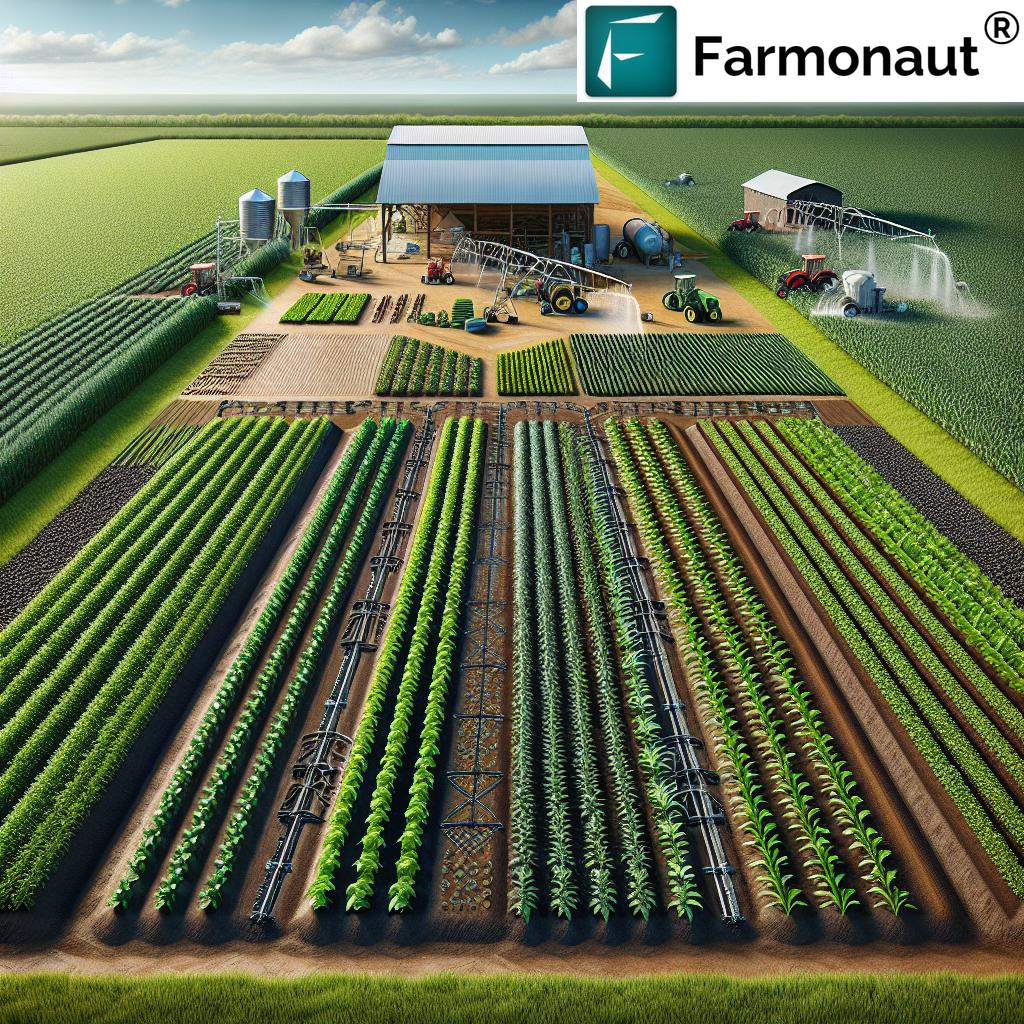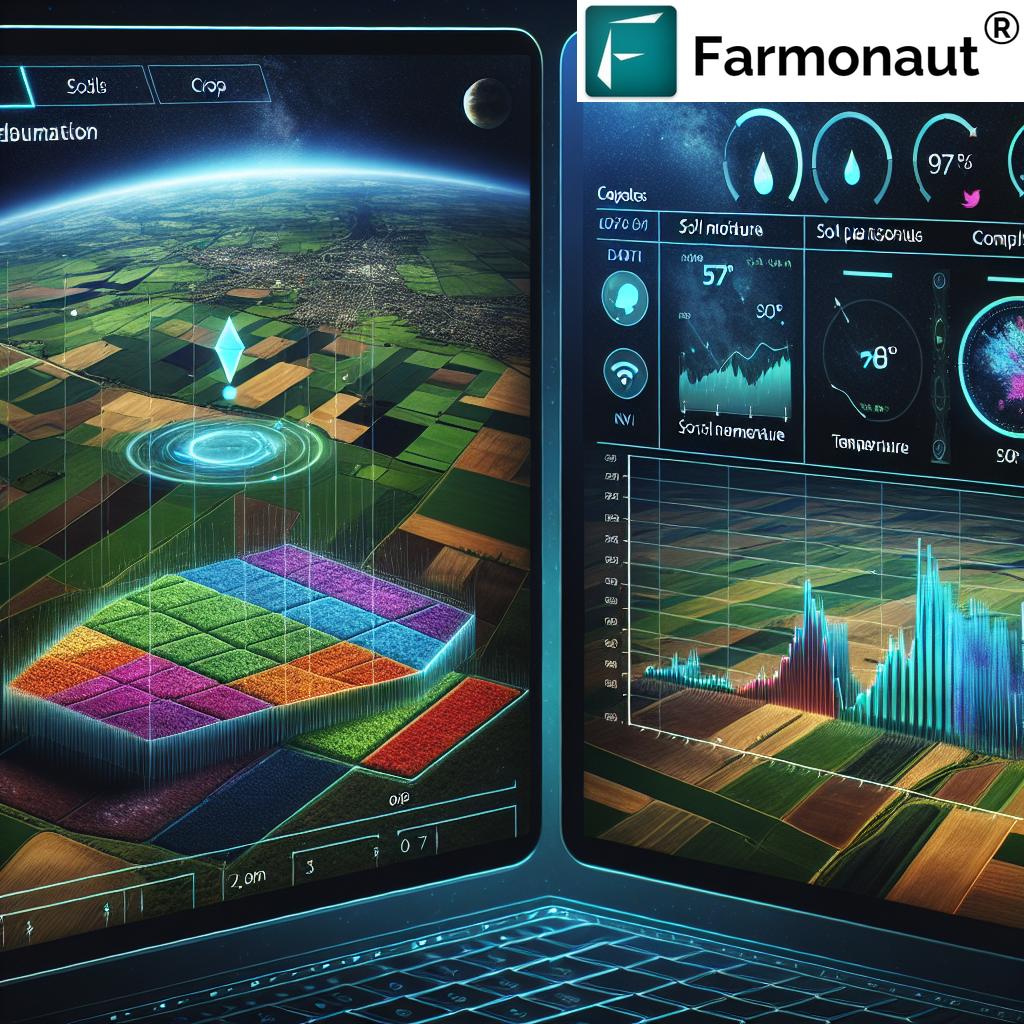Advance Agriculture Machine 2025: Precision & Eco Trends
“By 2025, precision agriculture machines are projected to increase crop yields by up to 20% globally.”
Table of Contents
- Introduction to Advance Agriculture Machine 2025
- The Evolution of Machine Agriculture
- AI & IoT: Revolutionizing Agricultural Machinery 2025
- Autonomous Machines: Harvesters, Tractors, and Seeders
- Precision Agriculture Machines & Advance Eco Agriculture
- Drones: Transforming Advance Agriculture Monitoring
- IoT, Data, and Smart Management in Modern Farms
- Sustainable Agriculture & Environmental Impact
- Farmonaut: Integrating Satellite Insights for Better Farming
- Comparison Table of Advanced Agricultural Machines: Features & Estimated Impact 2025
- Future Trends: What Awaits Farming in 2025 and Beyond
- Frequently Asked Questions (FAQ)
- Conclusion
Introduction to Advance Agriculture Machine 2025
As we approach 2025, the landscape of agriculture is being transformed by a technological revolution that is both rapid and profound. The advance agriculture machine phenomenon is no longer a vision of the future—it’s an evolving reality. Equipment and technologies like autonomous tractors, smart seeders, drones, and AI (artificial intelligence) are becoming indispensable tools for farmers aiming to boost productivity, optimize resource use, and meet the escalating global food demands without compromising sustainability.
The integration of advanced agricultural machinery may be the most significant breakthrough of our era, enabling us to minimize environmental impact, leverage big data analytics, and employ precision farming at a scale previously unimaginable. This technology-focused transformation stands at the cusp of delivering smarter, more efficient, and eco-friendlier farms worldwide.
In this comprehensive guide, we explore how advance agriculture machine adoption—driven by developments in artificial intelligence, IoT (Internet of Things), robotics, and satellite technology—will redefine the future of agricultural practices and eco-agriculture in 2025—and beyond.
The Evolution of Machine Agriculture: From Traditional to Advanced
The journey from traditional farming to technologically powered machine agriculture has unfolded in remarkable phases. Until recently, manual labor and rudimentary equipment dominated the agriculture sector. However, relentless demands for increased efficiency due to rising population, food scarcity, and climate variability have necessitated an evolution in agricultural machinery.
- Pre-Industrial Age: Manual tools, animal power
- Industrial Age: First mechanical plows, basic tractors, and harvesters
- Green Revolution: Chemical fertilizers, diesel engines, large-scale machinery
- Digital Age: Data-driven systems, GPS-enabled equipment, early robotics
- Advance Agriculture Machine Age (2025): AI-powered, autonomous, IoT-connected, semi-robotic, eco-focused machines
Each phase saw innovations that made machines more efficient, complex, and automated, but none compare to the disruption brought by the upcoming era—where AI, data analytics, and autonomous systems synchronize seamlessly to revolutionize farming operations at every stage of the cycle.
The Current Landscape: Why Change Now?
With food security challenges intensifying and climate change implications accelerating, agriculture is under pressure to deliver more—from every acre farmed. For farmers and landowners, maintaining profitability while minimizing environmental impact compels adoption of sustainable, precision-focused machinery.
- Urbanization is reducing arable land but increasing food demand
- Labor shortages push the need for autonomous or driverless machines
- Global regulations demand reduced emissions and conservation of resources
This is why all eyes are on advancements in agriculture machine technology for 2025.
AI & IoT: Revolutionizing Agricultural Machinery 2025
The fusion of artificial intelligence (AI) and the Internet of Things (IoT) is the cornerstone of the new advance agriculture machine ecosystem. But how exactly do these technologies supercharge farm equipment and practices?
Artificial Intelligence (AI) in Agriculture Machine Operations
AI enables machines to learn, adapt, plan, and perform complex tasks with minimal human intervention. Examples include:
- Image recognition to identify crop health, soil status, and pest infestations via onboard cameras
- Predictive analytics for estimating yield, fertilizer application, and potential risk zones
- Smart scheduling for machines to optimize harvesting times and reduce labor costs
- Autonomous route planning with GPS guidance to avoid overlap and seed wastage
Advanced agriculture machines equipped with onboard AI processors transform static fieldwork into highly dynamic, data-driven activities.
IoT: Achieving Data-Driven Connectivity
IoT interlinks machines, sensors, and decision support systems. Machinery is equipped with soil moisture, weather, and nutrient level sensors—all wirelessly communicating actionable data to cloud platforms for real-time monitoring and management:
- Remote performance monitoring and predictive maintenance alerts
- Live transmission of environmental data: soil moisture, weather, nutrient status
- Seamless integration with farm management platforms
- Inter-equipment optimization: autonomous tractors adapt to conditions sensed by drones
Collectively, AI and IoT-powered machinery makes advance agriculture more efficient, responsive, and resilient for 2025 and beyond.
Key Benefits of AI & IoT Integration:
- Enables granular, real-time decisions at every operation stage
- Reduces operational risks via predictive analytics and timely intervention
- Optimizes resource allocation—saving water, fertilizers, and energy
- Facilitates traceability, transparency, and environmental compliance
Autonomous Machines: Harvesters, Tractors, and Seeders Leading the Advance Agriculture Machine Revolution
Perhaps the most visible breakthrough in 2025’s farming technology is the rise of autonomous machines. These include driverless tractors, self-guided harvesters, and seeders that function with minimal human involvement. Let’s explore how these technologies are reshaping agriculture:
1. Autonomous Tractors
- Equipped with GPS and machine learning algorithms
- Plows, tills, and seeds over vast tracts with impeccable precision
- Reduces labor costs and human error
- Minimizes soil compaction by calculating optimal paths
“AI-powered farm equipment can reduce fertilizer usage by approximately 15% through targeted application techniques.”
2. Smart Seeders
- Use sensor data to adjust seed depth, spacing, and rate
- Ensure uniform germination and reduce seed wastage
- Facilitate no-till planting, preserving soil structure
3. Autonomous Harvesters
- Employ multispectral cameras to detect crop ripeness
- Harvest only mature produce with minimal loss
- Work continuously for high field efficiency
All these machines are increasingly being integrated into a connected, AI-optimized system—making machine agriculture smarter, cleaner, and more responsive to both crop and environmental needs.
Discover how satellite-powered crop monitoring can revolutionize productivity and health assessment for farmers in 2025.
Precision Agriculture Machines & Advance Eco Agriculture
The precision revolution in advance agriculture machines represents a fundamental leap from “spray and pray” approaches to hyper-targeted application of resources. This new paradigm is often referred to as advance eco agriculture and revolves around three key pillars: data-driven insights, smart application of inputs, and environmental stewardship.
How Precision Equipment Works
- Soil Sensors: Continuously monitor moisture, temperature, pH, and nutrient levels—assisting with water and fertilizer management.
- Variable Rate Applicators: Adjust fertilizer or pesticide application in real-time, based on soil and crop health data.
- Multispectral Cameras: Mounted on machinery or drones, they provide detailed insights into plant vigor, pest infestations, and disease outbreaks.
- Precision Irrigation Systems: Apply water at precise locations and timings to reduce wastage.
This approach significantly reduces seed and fertilizer wastage, promotes sustainability, and minimizes harmful environmental impact.
Benefits of Precision & Eco Agriculture Equipment in 2025
- Higher crop yields through surgical precision in resource allocation
- Less water and fertilizer required—directly improving the farm’s profitability and sustainability
- Lower environmental pollution from over-application
- Improved resilience to climate impacts by optimizing input amidst variable weather
- Traceability and transparency—from seed to harvest
Drones: Transforming Advance Agriculture Monitoring
Drones are at the forefront of machine agriculture innovations. By combining aerial perspectives, multispectral imaging, and rapid deployment, agricultural drones provide farmers with actionable intelligence for crop health, pest detection, and targeted resource application.
Key Roles of Drones in 2025
- Large-area monitoring for crop health, disease outbreaks, and moisture levels
- Precision spraying of fertilizers, pesticides, and biologicals—minimizing human exposure and chemical waste
- Integrating with other agriculture machine systems for immediate intervention
- Supporting traceability and real-time compliance reporting
Notably, drones integrate with farm management software, providing real-time data that can be instantly analyzed, visualized, and acted upon.
Learn how real-time data analytics and drone insights can be integrated into admin platforms to enhance farm oversight and efficiency.
IoT, Data, and Smart Management in Modern Farms
The real power of advance agriculture machine technology unveils itself in data management and connectivity. Sensor-equipped machines and IoT-enabled devices constantly gather data on:
- Soil health and composition
- Weather changes and microclimates
- Crop status and plant growth cycles
- Water usage and irrigation performance
Collected data are processed in powerful analytics platforms, enabling farmers to make informed, timely decisions—directly from their smartphones or computer systems.
Farmonaut, for example, empowers users with satellite-based real-time insights, AI-driven advisories, and environmental impact monitoring that can seamlessly tie into machine agriculture platforms and data management systems.
-
Large Scale Farm Management Solutions:
Our satellite-driven platform delivers multi-field monitoring, vegetation health mapping, and comprehensive farm management—enabling users to oversee expansive operations with unmatched precision and resource efficiency. -
Fleet Management Tools:
Track all your equipment, vehicles, and fleet assets via satellite and IoT, minimizing downtime and ensuring efficient logistics in agriculture and environmental projects. -
Carbon Footprinting:
Leverage AI-based tools to track, monitor, and minimize the carbon footprint of your fields—promoting sustainable agriculture practices and supporting regulatory compliance. -
Satellite-Based Crop Loan & Insurance Verification:
Secure agricultural loans and insurance with trusted, satellite-verified field data, reducing fraud and improving access to finance for all stakeholders. -
Blockchain-Based Traceability:
Ensure product and resource authenticity in the agri-supply chain through blockchain-backed monitoring.
Powerful API access:
Farmonaut API
(Developer Docs)
offers direct integration of satellite insights into your proprietary systems, automating everything from crop reporting to machinery management.
Sustainable Agriculture & Environmental Impact
Modern advance agriculture machines are not just about productivity, but also eco-sustainability. To address the dual challenge of increasing food production while minimizing environmental impact in 2025 and beyond, new categories of agricultural equipment have emerged:
Eco-Focused Machinery & Practices
- No-Till Seeders: Plant seeds without disrupting soil strata, preserving microorganism populations, water retention, and soil structure.
- Lightweight Electric Tractors & Robotics: Drastically reduce soil compaction and carbon emissions.
- Solar-Powered Equipment: Reduces reliance on fossil fuels and lowers the farm’s operational carbon footprint.
- Fertilizer Application Robots: Apply just the right amount, in the right place, at the right time—eliminating excess and runoff.
- Smart Sprayers: Use vision-sensing technology to target only weed-impacted areas, drastically minimizing chemical pollution.
Environmentally-conscious advance agriculture machines are key to sustainable food production and ecological stewardship for the long term.
Farmonaut: Integrating Satellite Insights for Better Farming in 2025
Farmonaut stands at the forefront of satellite-driven agricultural intelligence. By combining satellite imagery, AI, and blockchain, we support farmers, agri-businesses, and governments in optimizing every aspect of machine agriculture and resource management—from soil health and crop vigor to fleet logistics and carbon footprint reduction.
How Satellite Technology Enhances Machine Agriculture
- Multispectral Satellite Monitoring: Understand crop stress, soil moisture, and yield estimation at field—regional—global scale.
- AI-Based Advisory (Jeevn): Receives constant satellite feeds to suggest the best timings for planting, irrigation, fertilization, and harvesting.
- Blockchain-Enabled Traceability: Tracks every stage of production for transparency and regulatory assurance.
- Fleet & Resource Optimization: Coordinates operations, reduces unnecessary travel, and curtails resource wastage with live data.
- Environmental Impact Monitoring: Empowers sustainable practices through automated carbon and emissions tracking.
Accessing these insights is easier than ever with our Web, Android, & iOS Apps.
For developers and businesses, robust APIs allow for seamless integration into proprietary machinery and farm management systems.
Comparison Table of Advanced Agricultural Machines: Features & Estimated Impact 2025
| Machine Type/Name | Core Technology Used | Main Function | Estimated Efficiency Gain (%) | Estimated Resource Savings (%) | Environmental Impact |
|---|---|---|---|---|---|
| AI-Driven Autonomous Tractor | AI, Machine Learning, IoT | Plowing, Seeding, Field Preparation | 22% | 18% | Medium – Lower emission, reduced compaction |
| Smart Precision Seeder | IoT, Sensors, GPS | Targeted Seed Placement | 16% | 20% | Low – Less seed wastage, soil integrity preserved |
| Autonomous Harvester | AI, Robotics, Multispectral Cameras | Selective Crop Harvesting | 28% | 14% | Medium – Efficient, lower fuel use |
| Drone Sprayer & Surveillance | AI, IoT, Imaging Sensors | Targeted Spraying, Crop Health Monitoring | 17% | 25% | Low – Reduced chemical runoff |
| Remote Crop Health Sensors | Satellites, IoT, AI | Continuous Soil & Vegetation Mapping | 19% | 21% | High – Promotes sustainable input usage |
| Electric Robotics (Weeding/Fertilizing) | Robotics, AI, Battery Tech | Automated Weeding, Variable Fertilizer Application | 13% | 18% | High – Zero emissions, less soil disturbance |
| Smart Irrigation Systems | IoT, Big Data Analytics | Water Application Optimization | 15% | 26% | Low – Eliminates over-irrigation |
These comparisons illustrate how the integration of AI, IoT, and robotics is driving the next leap in efficiency, resource savings, and sustainability.
Future Trends: What Awaits Farming in 2025 and Beyond
Key Trends Shaping the Next Era of Machine Agriculture:
- Full Automation Adoption: With labor shortages and strict environmental requirements, fully autonomous fields will become commonplace—reducing manual intervention to a minimum.
- Renewable Energy Integration: Expect a surge in solar-powered and electric field equipment—lowering the sector’s carbon footprint and operating costs.
- Increased Dependency on Satellite Data: Satellite intelligence will provide hyper-local, real-time data for precision application and overall ecosystem management.
- Digital Traceability Becomes Norm: Blockchain-based traceability will support compliance, transparency, and food safety in global supply chains.
- Hyper-Personalized Advisory Systems: Apps and platforms will deliver field- and crop-specific advice, leveraging a fusion of satellite feeds, on-ground sensors, and AI.
- Collaboration Between Machines and Humans: Autonomous machines will manage everyday tasks, while humans focus on decision-making, planning, and creative problem-solving.
- Rise of Smart, Modular Equipment: Expect multi-purpose, upgradable machinery using plug-and-play software compatible with most leading analytics and management platforms.
Frequently Asked Questions (FAQ)
Q1. What is an advance agriculture machine?
An advance agriculture machine is a high-tech farming equipment powered by AI, IoT, robotics, and satellite technology to optimize every stage of the farming cycle—from soil preparation and seeding to crop monitoring, irrigation, and harvesting.
Q2. How does AI improve agricultural machinery in 2025?
AI enables machines to learn, adapt, automate, and optimize. AI-equipped tractors, harvesters, and drones can self-navigate, diagnose crop and soil health, and provide data-driven recommendations to minimize resource use and maximize yields.
Q3. How do drones help in modern farming?
Drones play a critical role in advance agriculture monitoring—offering rapid, large-area coverage for crop health assessment, targeted spraying of inputs, and early detection of pest or disease outbreaks.
Q4. What are eco-agriculture practices using advanced machines?
Eco-agriculture uses technology like no-till seeders, precision irrigation, and AI-driven input application to boost productivity while minimizing soil degradation, water wastage, and environmental pollution.
Q5. How does Farmonaut support machine agriculture?
Farmonaut provides satellite-based crop monitoring, AI advisory systems (e.g., Jeevn), blockchain traceability, and fleet management—integrating seamlessly with machinery and farm management apps to optimize resource use, monitor productivity, and reduce environmental impact.
Q6. Are these machines affordable for small to medium scale farmers?
Many solutions, especially satellite-driven analytics and IoT-integrated machinery monitoring offered by Farmonaut, are increasingly cost-effective—thanks to affordable subscription plans, API integrations, and scalable mobile/web apps.
Q7. What is the importance of traceability and transparency in 2025’s agriculture?
Traceability ensures product authenticity, promotes food safety, and meets regulatory needs—boosting consumer confidence. Technologies like those on the Farmonaut Blockchain Traceability Platform make this process smooth and tamper-proof.
Q8. Can Farmonaut insights be integrated with other AI-driven agricultural platforms?
Absolutely. Farmonaut’s open API enables integration of real-time satellite and environmental data into third-party platforms, machinery software, or custom decision-support systems.
Conclusion
As farming surges into 2025, the role of advance agriculture machine and supporting technologies cannot be overstated. From autonomous tractors and smart seeders to drone-powered monitoring and satellite analytics, the era of traditional agriculture is giving way to a world defined by precision, data-driven decision making, and eco-conscious resource use.
At Farmonaut, our mission is to make advanced satellite-based insights accessible for farmers, enterprises, and governments worldwide, supporting the integration and optimization of modern agricultural machinery regardless of scale or geography. By embracing innovation, investing in sustainability, and leveraging the very best tools of the advance agriculture machine revolution, the future of farming can be as productive as it is responsible.
Ready to experience the power of next-gen farm management, blockchain traceability, or environmental impact tracking?
Explore our solutions for carbon tracking, large-scale field management, fleet management, and more to elevate your agriculture machine operations. Bring the future closer—with powerful, data-driven farm insights, all on one platform.
Advancements in Agricultural Machinery: Shaping the Future of Farming in 2025.
The advance agriculture machine era is here—transforming fields, boosting efficiency and sustainability, and offering unparalleled precision through smart technologies. Let Farmonaut help you lead this revolution in your fields!













